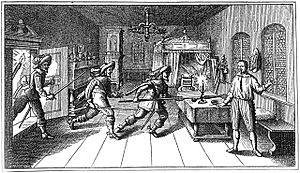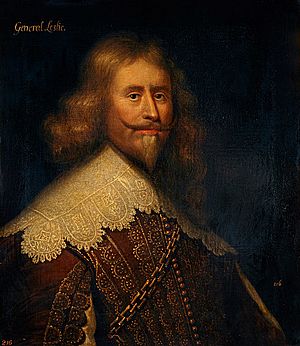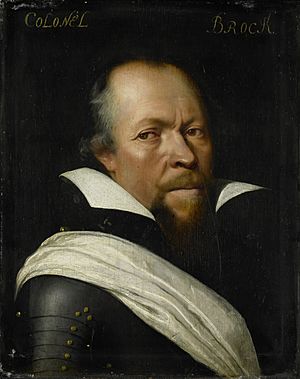Scotland and the Thirty Years' War facts for kids

Scotland and its people were deeply involved in the Thirty Years' War, a huge conflict in Europe from 1618 to 1648. This war mainly took place in the Holy Roman Empire. Many Scots played a part in the fighting and the diplomatic talks. There were several reasons why Scotland got involved in this big war.
One main reason was the fate of Elizabeth of Bohemia. She was a Scottish princess, the daughter of King James VI & I. Her situation became a key concern for many Scots. Up to 50,000 Scottish soldiers went to Europe to fight. They were recruited with official papers from the Scottish government and signed by the king. These soldiers usually joined when an ally was fighting against the Habsburg family. Many Scots served in special Scottish groups that already existed in the Dutch Republic and Sweden before 1618. Later, new army groups were formed in Denmark-Norway and France for more Scottish soldiers. Some Scots fought for better opportunities, some for family loyalty. Others fought for their beliefs or to support certain royal families. Only a few were simply soldiers for hire. Even though Scots fought throughout the war, Scotland as a nation only formally declared war on Spain (1625–1630) and France (1627–1629). Most Scots served in foreign armies with the king's permission.
Contents
Scotland's Role in a Big War
Through their service, many ambitious Scots became very important in European courts. They helped with diplomacy and even led large armies. These leaders included General Sir James Spens, Lieutenant General Patrick Ruthven, Lieutenant General James King, and Field Marshal Alexander Leslie. All of these men served in Sweden. Another Scottish-English army, led by James, 3rd Marquis Hamilton, also joined the Swedish forces in Germany from 1631 to 1632.
Brave Scottish Leaders
In France, key Scottish officers were Marechal de France John Hepburn (1634–1636), who had previously served in Sweden, and Sir Robert Moray (in the 1640s). In Denmark, Robert Maxwell, Earl of Nithsdale, led a group of Scots. This group included Donald Mackay, Lord Reay, Colonel Robert Monro, and Alexander Lindsay, 2nd Lord Spynie (1627–1629).
The Famous Scots Brigade
The Scots Brigade was another important group for Scottish soldiers. It had been around since 1572. These soldiers worked for the Dutch Republic and were paid by them. However, they were still very loyal to the House of Stuart. Many Scottish soldiers might have joined the Dutch army because of their religious beliefs. They might have been part of a wider movement of "Calvinist Internationalism." Important officers in the Scots Brigade included Colonel William Brog, William Balfour, and James Livingston, 1st Earl of Callendar. Several generations of the Lords and Earls of Buccleuch also served. The Scots Brigade fought in many famous battles during the Eighty Years' War. These included the Battle of Nieuwpoort (1600), the Siege of Ostend (1601-1604), and the Siege of Breda (1637).
Scots on Different Sides
Not all Scots fought for Elizabeth of Bohemia or the Protestant armies in the north. Some Scots fought for the Habsburgs, who were the rulers of Austria and Spain. They had their own reasons, just like their countrymen on the other side. Some believed strongly in the Catholic Counter-Reformation. Others were forced by their situation, or they were simply looking for opportunities. One such person was Count Walter Leslie, who was involved in the assassination of Albrecht von Wallenstein, a famous general.
Coming Home: The Covenanter Armies
Thousands of Scottish soldiers returned home from fighting in Europe. They joined the Covenanter armies in Scotland. These returning soldiers included experienced leaders like Alexander Leslie and General of Artillery Alexander Hamilton. These veterans were very important in training the new Covenanter recruits. However, some senior officers, like Lieutenant General Patrick Ruthven and Lieutenant General James King, returned to fight against their former comrades. Both the Covenanters and the Royalists brought back officers who had learned the "Swedish Discipline" (a way of training armies). This training was then used in their own armies. In 1644, during the wars in England, a strange situation happened. Alexander Leslie, Earl of Leven, led the main parliamentary army. His opponent was Patrick Ruthven, now Earl of Forth, who led the Royalist forces. Both men survived the war and lived long lives.
Important Scottish Figures
Many important Scots were involved in the Thirty Years' War.
Kings and Queens
- James VI & I – He was King of Scotland from 1567 to 1625. He also became King of England and Ireland in 1603.
- Elizabeth of Bohemia – She was the daughter of King James VI. This Scottish-born princess became Queen of Bohemia when her husband, Frederick V of the Palatinate, accepted the Bohemian Crown.
- Charles I – He was the son of James VI. This Scottish-born prince ruled as King of Scotland, England, and Ireland from 1625 to 1649.
Top Generals

- Robert Douglas, Count of Skenninge – He became a field marshal in the Swedish army.
- James Hamilton, Marquis of Hamilton – He was a "General of British" in the Swedish army in Germany.
- John Hepburn – He became a Marechal de France and field marshal in the French army.
- James King, Lord Eythin – He was a lieutenant-general in the Swedish army.
- Alexander Leslie, Earl of Leven – He was a field marshal in the Swedish army and won the Battle of Wittstock in 1636.
- Patrick Ruthven, Earl of Forth – He was a field marshal in the Swedish army.
- James Spens – He was a "General of British" and "General of Scots" in the Swedish army.



